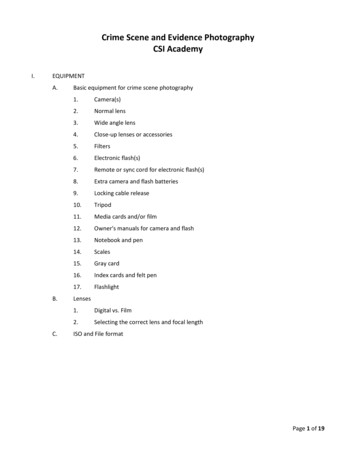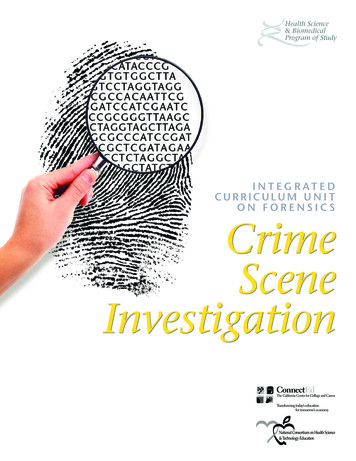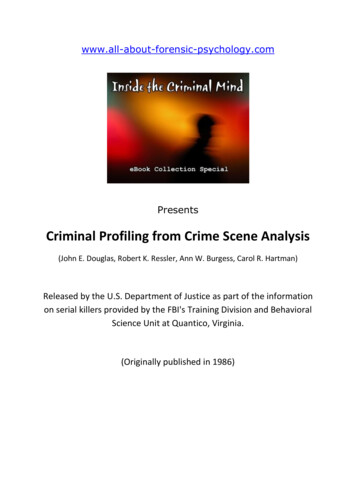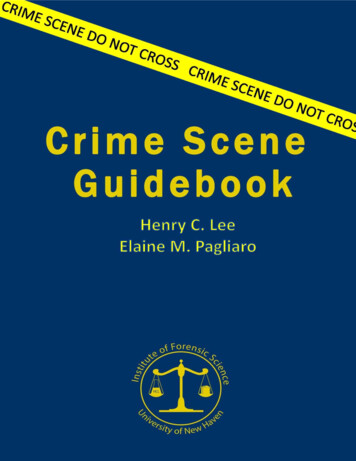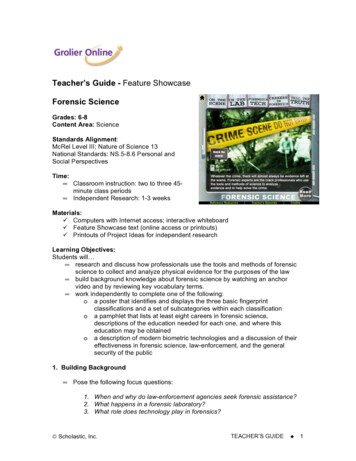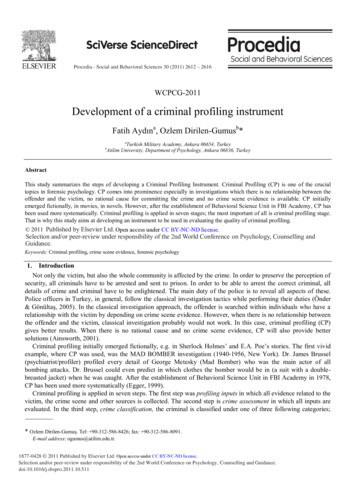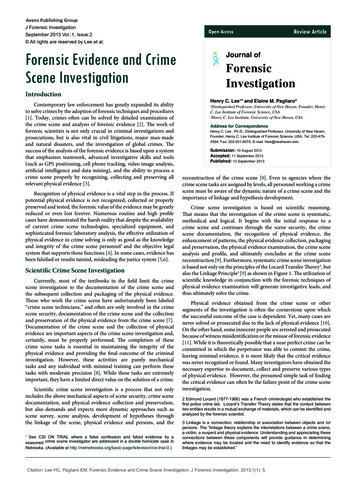
Transcription
Avens Publishing Groupt ing Innova t ionsJInviForensicInvestigationSeptember 2013 Vol.:1, Issue:2 All rights are reserved by Lee et al.Open AccessForensic Evidence and CrimeScene InvestigationJournal ofForensicInvestigationIntroductionContemporary law enforcement has greatly expanded its abilityto solve crimes by the adoption of forensic techniques and procedures[1]. Today, crimes often can be solved by detailed examination ofthe crime scene and analysis of forensic evidence [2]. The work offorensic scientists is not only crucial in criminal investigations andprosecutions, but is also vital in civil litigations, major man-madeand natural disasters, and the investigation of global crimes. Thesuccess of the analysis of the forensic evidence is based upon a systemthat emphasizes teamwork, advanced investigative skills and tools(such as GPS positioning, cell phone tracking, video image analysis,artificial intelligence and data mining), and the ability to process acrime scene properly by recognizing, collecting and preserving allrelevant physical evidence [3].Recognition of physical evidence is a vital step in the process. Ifpotential physical evidence is not recognized, collected or properlypreserved and tested, the forensic value of the evidence may be greatlyreduced or even lost forever. Numerous routine and high profilecases have demonstrated the harsh reality that despite the availabilityof current crime scene technologies, specialized equipment, andsophisticated forensic laboratory analysis, the effective utilization ofphysical evidence in crime solving is only as good as the knowledgeand integrity of the crime scene personnel1 and the objective legalsystem that supports those functions [4]. In some cases, evidence hasbeen falsified or results tainted, misleading the justice system [5,6].Scientific Crime Scene InvestigationCurrently, most of the textbooks in the field limit the crimescene investigation to the documentation of the crime scene andthe subsequent collection and packaging of the physical evidence.Those who work the crime scene have unfortunately been labeled“crime scene technicians,” and often are only involved in the crimescene security, documentation of the crime scene and the collectionand preservation of the physical evidence from the crime scene [7].Documentation of the crime scene and the collection of physicalevidence are important aspects of the crime scene investigation and,certainly, must be properly performed. The completion of thesecrime scene tasks is essential in maintaining the integrity of thephysical evidence and providing the final outcome of the criminalinvestigation. However, these activities are purely mechanicaltasks and any individual with minimal training can perform thesetasks with moderate precision [8]. While these tasks are extremelyimportant, they have a limited direct value on the solution of a crime.Scientific crime scene investigation is a process that not onlyincludes the above mechanical aspects of scene security, crime scenedocumentation, and physical evidence collection and preservation,but also demands and expects more dynamic approaches such asscene survey, scene analysis, development of hypotheses throughthe linkage of the scene, physical evidence and persons, and the1See CSI ON TRIAL where a false confession and faked evidence by aseasoned crime scene investigator are addressed in a double homicide case inNebraska. (Available at rial-0.)Review ArticleHenry C. Lee1* and Elaine M. Pagliaro21Distinguished Professor, University of New Haven; Founder, HenryC. Lee Institute of Forensic Science, USA2Henry C. Lee Institute, University of New Haven, USAAddress for CorrespondenceHenry C. Lee , Ph.D., Distinguished Professor, University of New Haven,Founder, Henry C. Lee Institute of Forensic Science, USA, Tel: 203-4794594; Fax: 203-931-6074; E-mail: hlee@newhaven.eduSubmission: 10 August 2013Accepted: 11 September 2013Published: 13 September 2013reconstruction of the crime scene [9]. Even in agencies where thecrime scene tasks are assigned by levels, all personnel working a crimescene must be aware of the dynamic nature of a crime scene and theimportance of linkage and hypothesis development.Crime scene investigation is based on scientific reasoning.That means that the investigation of the crime scene is systematic,methodical and logical. It begins with the initial response to acrime scene and continues through the scene security, the crimescene documentation, the recognition of physical evidence, theenhancement of patterns, the physical evidence collection, packagingand preservation, the physical evidence examination, the crime sceneanalysis and profile, and ultimately concludes at the crime scenereconstruction [9]. Furthermore, systematic crime scene investigationis based not only on the principles of the Locard Transfer Theory2, butalso the Linkage Principle3 [9] as shown in Figure 1. The utilization ofscientific knowledge in conjunction with the forensic techniques ofphysical evidence examination will generate investigative leads, andthus ultimately solve the crime.Physical evidence obtained from the crime scene or othersegments of the investigation is often the cornerstone upon whichthe successful outcome of the case is dependent. Yet, many cases arenever solved or prosecuted due to the lack of physical evidence [10].On the other hand, some innocent people are arrested and prosecutedbecause of witness misidentification or the misuse of forensic evidence[11]. While it is theoretically possible that a near perfect crime can becommitted in which the perpetrator was able to commit the crime,leaving minimal evidence, it is more likely that the critical evidencewas never recognized or found. Many investigators have obtained thenecessary expertise to document, collect and preserve various typesof physical evidence. However, the presumed simple task of findingthe critical evidence can often be the failure point of the crime sceneinvestigation.2 Edmund Locard (1877-1966) was a French criminologist who established thefirst police crime lab. Locard’s Transfer Theory states that the contact betweentwo entities results in a mutual exchange of materials, which can be identified andanalyzed by the forensic scientist.3 Linkage is a connection, relationship or association between objects and /orpersons. The “linkage theory explains the interrelations between a crime scene,a victim, a suspect and physical evidence. Understanding and appreciating theseconnections between these components will provide guidance in determiningwhere evidence may be located and the need to identify evidence so that thelinkages may be established.”Citation: Lee HC, Pagliaro EM. Forensic Evidence and Crime Scene Investigation. J Forensic Investigation. 2013;1(1): 5.
Citation: Lee HC, Pagliaro EM. Forensic Evidence and Crime Scene Investigation. J Forensic Investigation. 2013;1(1): 5.ISSN: 2330-03967. The activity (e.g. active, passive scenes); and8. The size of the crime scene (e.g. universal, macroscopic,microscopic scene).Locard Exchange4-Way LinkageFigure 1: Transfer Theory in Forensic Science.One common practice is to collect everything that could be, inany possible manner, construed as evidentiary in nature [12]. Thissort of practice is not only a waste of time and resources, but couldpotentially cause legal and investigative issues; if every object at ascene is collected and submitted to the forensic laboratory for furtheranalysis, the forensic facility will be overwhelmed, and it is more likelythat some of the evidence collected will have no probative value [9].Examination of materials unrelated to the incident may also provide“false leads” which will waste valuable resources and may lead to thearrest of the wrong person. On the other hand, the identification ofevidence that has so-called “probative value” (evidence that is proofof or has a tendency to prove a fact at issue) is sometimes the focusof some crime scene analysts. Care should be taken when using thisapproach as well, since valuable evidence may be overlooked in aneffort to prove a hypothesis or link the scene to a specific suspect.If critical evidence is omitted or improperly preserved, no type ofmodern, state-of-the-art laboratory instrumentation and technologywill be able to salvage the investigation [9]. Hence, a system must bedeveloped where the relevant physical evidence is recognized andlocated, while superfluous materials are excluded. This will only resultif the crime scene investigators understand the goals of a crime scenesearch, grasp the concepts and techniques for effective searching, androutinely exercise the discipline necessary to rely on a systematic,structured search process with a completely objective and open mind.After physical evidence has been identified at a scene, subsequentpreservation, handling and analysis must satisfy both scientific andlegal requirements if that evidence is to be considered reliable anduseful in court proceedings.Types of Crime ScenesThere are many ways to classify a crime scene [9]:1. The original location at which the crime was committed (e.g.primary scene, secondary scene);2. The type of crime committed (e.g., homicide, sexual assault,robbery);3. The physical location (e.g., indoor, outdoor);4. The physical condition (e.g., buried, underwater);This appears relatively simple. However, sometimes it is not a clearcut process in a complex situation. While sometimes useful to focuson significant evidence, crime scene personnel should understandthese classification systems and how to develop multiple alternatehypotheses based on experience and observation. It is important tokeep in mind that there is no single classification method that willsatisfy all the elements of the crime scene and its investigation. It isessential that crime scene investigators develop the ability to utilizetheir analytical skills and logical approaches to make an initialdetermination regarding the number and types of crime scenes thatwere involved in the commission of the crime. Finding the exact,precise boundaries of a crime scene may be difficult, and may requireadjustments after the initial observations.Once a crime scene has been defined and a “boundary” has beenestablished, the crime scene(s) should be secured and processedaccordingly. Any actions taken at the crime scene should meet all thelegal and scientific standards and requirements. Once the locationsare determined, the proper sequence of events of the crime can beestablished, and thus the physical evidence from each of the scenescan be successfully recognized [13]. The crime scene investigationand the forensic process will thus begin.Physical Evidence at the Crime ScenePhysical evidence can be classified according to its physical state,the type of crime, and the nature of the evidence, its composition, orthe types of questions to be resolved [14]. Each of these classificationsis useful for offering conceptual ideas and practical approachesin the crime scene investigation. It is important for a crime sceneinvestigator to understand the value of physical evidence, as well asthe limitations of physical evidence, to appreciate the interaction ofvarious definitions or classifications of crime scenes, to recognizethe theory of transfer evidence, and to understand the propermethodologies for locating microscopic crime scenes within themore obvious macroscopic crime scenes. It is from the analysis ofthe crime scene that the crime scene investigator can determine whattype of physical evidence will most likely be found at a particular typeof crime scene, where to find the physical evidence at a particular typeof crime scene, and how to recognize, collect, preserve and processthe physical evidence. Finally, based upon the examination resultsof physical evidence, the investigator should be able to accuratelyreconstruct the crime scene.We generally perceive the relevant forensic evidence to includeitems such as a weapon used at a homicide, a bullet found in avictim’s body, or a bloodstain pattern. However, in any given case,any particular object may prove to be the crucial piece of physicalevidence necessary to solve the crime. Thus, physical evidence can bebest described as any evidence that can provide useful information toinvestigate the crime [15].5. The boundaries of the scene (e.g., house, train, bank,An alternative concept in classification of physical evidence isbased upon the nature and form of the evidence: transient, conditional,pattern, transfer, medical, electronic and associative [14].6. The appearance of the crime scene (e.g. organized,a. Transient evidencecomputer, car);disorganized crime scene);J Forensic Investigation 1(1): 5 (2013)Transient evidence is a type of evidence that is, by its very nature,Page - 02
Citation: Lee HC, Pagliaro EM. Forensic Evidence and Crime Scene Investigation. J Forensic Investigation. 2013;1(1): 5.ISSN: 2330-0396temporary, easily changed or lost. Commonly encountered transientevidence includes odors, temperatures, color, and some biologicaland physical phenomenon such as rigidity or the drying of blood. Dueto its temporary nature, this type of evidence must be documented assoon as the evidence is observed.b. Conditional evidenceConditional evidence is generally produced by a set of actionsor inactions. Similar to transient evidence, if conditional evidence isnot observed and documented immediately at the crime scene, theevidence will be lost forever. Examples of commonly encounteredconditional evidence include lighting conditions, television andcomputer settings, smoke or fire, condition of the victim’s body,window positions, or exact locations of specific evidences within thescene.c. Pattern evidenceThere are a variety of patterns that can be found at a crime scene.Most of these patterns are in the form of imprints, indentations,striations, or other markings such as fractures or depositions. Thepatterns commonly found at different crime scenes includes bloodspatter or stain patterns, glass fracture patterns, fire burn patterns,furniture position patterns, projectile trajectory patterns, track-trailpatterns, clothing or article patterns, tire or skid mark patterns,modus operandi patterns, and gun powder or residue patterns.d. Transfer evidenceTransfer evidence, also referred to as trace evidence, is generallyproduced by physical contact between persons, objects, or personsand objects. Some most commonly found transfer evidence is blood,fingerprint, hair, fiber, body fluids, soil, glass, drugs and chemicals.This type of evidence is the traditional forensic evidence examined inthe forensic laboratory.e. Medical evidenceMedical evidence not only consists of victim’s, suspect’s, orwitness’s injuries, the type and degree of injury the location andcondition of a wound, the number and size of the wounds, but alsoincludes medical history, the type of medical equipment on theperson, house or car, the prescription history, including date andamount prescribed.f. Electronic evidenceDue to recent advances in and availability of electronic devices,most individuals own a cell phone, PC, IPod, IPad and other personaldevices. Many households and businesses have installed surveillancecameras, monitors and other recording equipment. Investigatorsshould collect and preserve all these types of devices and any digitalcameras, phone answering machines, video cameras, computersand data storage devices. Examples of information that may provideinvestigative leads include cell phone call records, e-mail messagesrecovered from a suspect’s computer hard drive, and videotaperecorded from a bank security camera.g. Associative evidenceDuring the course of an investigation, specific items located at acrime scene may be used as evidence to associate a victim or suspectwith a particular scene. It may also be used to associate a victim to asuspect. Examples of associative evidence includes suspect’s vehicleJ Forensic Investigation 1(1): 5 (2013)or wallet found at the crime scene, victim’s ring, watch or otherpersonal belongings found on the suspect, receipts, tickets or businesscards.Utilization of Crime Scene EvidencePhysical evidence recognition and laboratory analysis can behelpful in directing an investigation along a productive path. Not alltypes of physical evidence will be able to directly link to or identifya suspect. In fact, the most common use of physical evidence foundat crime scenes is to identify an unknown substance [16]. Examplesinclude the identification of suspected controlled substances orpoisons, identification of accelerants in fire debris, blood alcohollevels, and toxicology of blood specimens. Moreover, physicalevidence can provide indirect investigative information or leadsto solve a crime. This is the most important and significant use ofphysical evidence collected from the crime scene.Not every crime scene will have a “smoking-gun” or aneyewitness, but the scene will definitely contain physical evidencethat can provide help to the investigating officers. For example, in ahit-and-run investigation, a seven-layer paint chip from the victim’sclothing can be used to narrow down the number and kinds of carsthat could have been involved in the accident. Use of this informationand vehicle databases may greatly reduce the time spent on theinvestigation [17]. Furthermore, the size of a shoeprint found atthe scene may help the investigator eliminate a suspect or indicatepossible shoe class characteristics. The DNA profiles from the semenstain in a victim’s rape kit can lead to a potential suspect. The numberof different calibers of bullets found may indicate the number andtypes of weapons used to commit a crime. The locations of bloodspatters and fingerprint impressions can yield information aboutthe possible sequence of events at the scene; or the conditions of thispattern evidence could help identify the activities that occurred at thescene.Features and Process in Forensic ExaminationThe objectives of crime scene investigation are to recognize,document, collect, preserve interpret and reconstruct all the relevantphysical evidence at the crime scene. The goal is not to predeterminewhether a potential suspect is guilty or innocent. The major objectiveof physical evidence examination is to provide useful information forthe criminal investigator to investigate cases. It is the intersection ofthese objectives of crime scene investigations and the examinationof forensic evidence that defines a proper scientific crime sceneinvestigation.Once the evidence is submitted to the laboratory, scientificexaminations will be carried out based on the type of evidence, suchas firearms, handwriting, DNA, video, and fingerprint evidence. Nomatter what type of evidence is being analyzed, laboratory personnelmust follow the general principles of evidence examination, whichinclude four independent but connected steps [14].1. Recognition of an item or pattern as potential evidence orhaving significance is the first critical step. Failure to recognizecrucial evidence will be detrimental to the investigation byfailing to establish the vital links between the suspect, victim,crime scene and physical evidence seen in the four-waylinkage theory. Successful recognition of evidence depends onthe ability to know not only what is present to be found, butPage - 03
Citation: Lee HC, Pagliaro EM. Forensic Evidence and Crime Scene Investigation. J Forensic Investigation. 2013;1(1): 5.ISSN: 2330-0396also where to look for the relevant evidence. The next phaseof recognition is the ability to sort through numerous itemsand objects and to distinguish those with potential or actualrelevance from those with no value. Mastery of this skill isonly acquired through substantial training and experience.2. Identification of various forms of evidence is the next logicalstep. Essentially, identification is a classification scheme. Themore characteristics two or more items have in common,the more complex or discriminatory the identificationbecomes. Within forensic science, items are often identifiedby comparing selected class characteristics of an unknownobject with similar characteristics of a known standard. If theselected class characteristics are essentially the same betweenthe known and unknown samples, then the unknown objectcan be classified with the known. Moreover, these twosamples could have originated from the same source andfurther analysis is advised. If, however, there are significantdifferences in some of the selected class characteristics, thenthe unknown sample can be certainly excluded as comingfrom the same source as the known standard.3. Individualization is unique in forensic evidence analysis.It is also the area, which is most criticized and challengedin court. Following identification, forensic scientists maycontinue with their analysis to determine if a particularsample is unique, even among other members of the sameclass. This process is referred to as individualization. Whilenot all evidence has sufficient measurable characteristics tobe individualized, laboratory examinations will be conductedtoward that ultimate goal. If subsequent examinationsidentify any characteristics that are not common between theknown and unknown sample, then the samples are excludedfrom having the possibility of originating from a commonsource. Often times, examinations will result in a conclusionthat the compared objects are similar in all measurablenature, but they cannot be conclusively linked to a commonorigin. The recent report of the National Academy of Sciences(NAS) recognized a deficiency and lack of research in thisarea for some of the forensic disciplines, such as fingerprintsand firearms comparisons [4]. On the other hand, a statisticalanalysis of the significance of the common features may behelpful in evaluating the significance of individualization.In some disciplines, matches of characteristics will generallybe subject to statistical analysis, as with DNA profiles.These statistical interpretations are only as reliable as thepopulations and databases from which the conclusions arededuced [18]. Finally, not all types of forensic evidence canbe individualized; nor is there any statistical data associatedwith information stored in the some databases.other documentary and testimonial evidence are linked intoone entity. The amount of information that a reconstructionmay provide is limited by the above factors. The morerelevant and accurate the data compiled in a particular case,the greater the chance that reconstruction exercises will be ofvalue to the investigation [19].Crime scene reconstruction as a process is not limited to therecognition, collection and preservation of evidence. It also requiresthe determination or elimination of events or actions that occurred atthe crime scene through the analysis of the crime scene patterns, thelocation, sequence of deposit and position of the physical evidence,and the laboratory examination results of the physical evidence. Crimescene reconstruction involves the scientific analysis of a scene or theinterpretation of the scene pattern evidence; it involves the systematicstudy of related information ending in the logical formulation of atheory. The process of forensic examination is presented in Figure 2.Crime Scene as a Component of the Forensic SystemCrime scene investigation, as noted previously, is not justprocessing or documenting a crime scene, nor is it just the collectionor packaging of physical evidence. Careful processing, documentationand collection of physical evidence are integral parts of the forensicprocesses. But the foundation of all forensic investigations isthe ability of the crime scene investigator or forensic scientist torecognize potential physical evidence – large or small, visible orlatent, exculpatory or inculpatory – at a crime scene. The subsequentidentification of the physical evidence along with the determinationof the possible source or origin of that evidence is the next step.Proper crime scene investigation is the starting point in the processof establishing what happened, when it happened, where it happened,who was involved, and how it occurred.Contrary to the way it is portrayed in popular televisionprograms, crime scene investigation is neither glamorous nor carriedout in an easy or lackadaisical manner. It is an organized, methodical,systematic and logical process. To perform crime scene functionsproperly requires not only extensive training and experience on thepart of the investigator, but also absolute objectivity along with acoordinated team effort. Perhaps one of the most important issuesrelated to crime scene investigation today is the establishment ofprofessional standards [4]. An assessment of current standards in the4. Reconstruction is the final phase in the forensic examinationprocess. This phase is entirely dependant upon andinterpretation of relevant evidence. Reconstruction utilizesinvestigative information, crime scene information, andlaboratory analysis of the physical and pattern evidence. Thereconstruction process has been defined as one that involvesthe use of both inductive and deductive logic [9]. This can be acomplex task in which many types of physical evidence, patterninformation, analytical results, investigative information, andJ Forensic Investigation 1(1): 5 (2013)Figure 2: The Forensic Examination Process.Page - 04
Citation: Lee HC, Pagliaro EM. Forensic Evidence and Crime Scene Investigation. J Forensic Investigation. 2013;1(1): 5.ISSN: 2330-0396practices of collection, examination, and analysis of physical evidenceis needed. All professionals involved with crime scene investigation,forensic examination and the legal system must carefully assess theirroles in the investigative process and presentation of the forensicevidence in courts of law. Professionalism and ethical standards forall parties involved in both criminal and civil litigations need to bedeveloped.Despite the countless historical cases from which we can learnand improve, beginning with the OJ Simpson case, we continue towitness serious crimes going unsolved or ending without justicebeing served because of the needless errors associated with poor crimescene investigation practices. Virtually no jurisdiction in the UnitedStates or any foreign county has resolved this dilemma. It is ironicthat while forensic science has experienced significant technologicaladvancements and improvements, the forensic profession is morehighly scrutinized, and the integrity of forensic scientists is oftenchallenged in court. If the crime scene is not properly managed,all the technology and advancements we currently possess in theforensic laboratory become worthless. If forensic evidence is notintroduced during a court preceding or wrongfully presented, thejudicial system’s ability to serve justice is diminished.A high-quality crime scene process does not have to be elaborate orsophisticated. Rather, the simple, objective adherence to fundamentalprinciples and procedures is all that is necessary. The essential crimescene functions are recognition, documentation, collection andpreservation of all relevant physical evidence. If these elements areachieved, there will be a much higher probability that the case will beaccurately resolved through scientific interpretation of the evidenceand presentation of the available facts and data in the court system.ConclusionIt is the police officers, detectives, crime scene investigators orevidence technicians that usually complete the crime scene searchand begin the forensic investigation stages. Crime scene investigatorsand laboratory personnel continue the forensic analysis of evidenceto obtain data that can be useful to the justice system. During thepretrial or initial litigation stages, the prosecution and defense counseldetermine which physical evidence will be utilized. During the trialor adjudication stages, the judge determines the admissibility of theforensic evidence. There is no guarantee that any of these parties whoare part of the evidentiary process will sufficiently understand the fullpotential of forensic evidence. This understanding of practitioners canbe enhanced through continued education at conferences, workshopsand other training opportunities.After two years of study, the NAS issued a final report on thestatus of forensic science. As highlighted in that report, several areasrequire attention to improve forensic science: The need for empiricalresearch in some forensic subspecialties; the need for certification,accreditation and quality assurance/ quality control programs inthe forensic laboratory; the importance of increasing funding forlaboratories; education needs for scientist; and standardization[4]. The training, education and standardization of crime sceneinvestigation are equally critical for the improvement of forensicservices. This training can take many forms including traditionalclassroom and workshop formats, access to on-line programs,webinars and degree programs in investigation or forensic science.As a greater number of police officers and attorneys acquire updatedinformation and receive new, specialized training in forensic science,the current situation should improve. The end result would be tomake forensic science even more valuable and to maintain the highquality of justice that this society deserves.References1. Inman K, Rudin N. (2001) p 41 in Principle and Practice of Crimnalistics: theprofession of forensic science. CRC Press, Boca Raton, FL.2. Joseph L. Peterson, John P. Ryan, Pauline J Houlden , Steven ihajlovic(1986) Forensic Science and the Courts: The Uses and Effects of ScientificEvidence in Criminal Case Processing, NCJRS Reports. U.S. Department ofJustice, Washington, DC.3. Gaensslen, RE, Harris H, Lee, HC (2008) Introduction to Forensi
to solve crimes by the adoption of forensic techniques and procedures [1]. Today, crimes often can be solved by detailed examination of the crime scene and analysis of forensic evidence [2]. The work of forensic scientists is not only crucial in criminal investigations and prosecution
